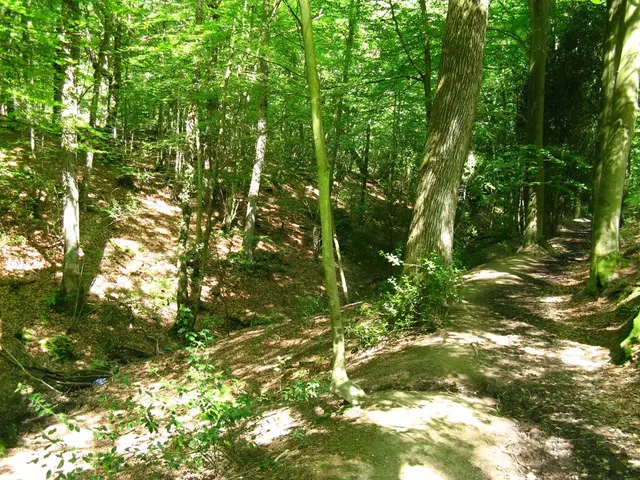Undercurrents in Tranquil Facade
Under the blazing sun, the Kok River glimmers as it meanders through the northern provinces of Chiang Mai and Chiang Rai, eventually joining the Mekong River. Once a lifeline for local farms, fisheries, and tourism, the river now casts a pall of fear and uncertainty.
A toxic menace thrives beneath its shimmering surface: arsenic, a hazardous heavy metal, has been detected in alarming quantities, leaving the villagers who rely on it for their water, their livelihoods, and their health with a growing sense of dread.
In the peaceful village of Ban Huai Kum, nestled in Chiang Rai's Muang district, Supin Kamjai, aged 63, gazes sorrowfully at her withered vegetables. "We've stopped using the river water," she says, her voice hollow. "But what good does that do now?" Her gnarled hands, hardened by decades of farming, gesture towards the wilting crops - a harvest that should have sustained her family for months.
Boonchai Phanasawangwong, a local community rights advocate, echoes the concern: "Our children play in the river, and now they have red, itchy rashes. We don't know if it's from the arsenic, but no one has bothered to check on us."
The crisis started in late 2024 when the once-clear water turned murky. In Ban Kwae Wua Dam, children began developing rashes after playing in the river.
In Huai Chomphu, farmers noticed their crops wilting despite diligent watering. By early 2025, lab tests confirmed their worst fears: the river was contaminated with alarmingly high levels of arsenic.
The contamination was particularly severe in Mae Ai district, Chiang Mai, where arsenic levels reached 0.026 milligrams per liter (mg/L) - far above the safety standard of 0.01 mg/L. Lead was also found at 0.076 mg/L, surpassing the safe limit of 0.05 mg/L.
Dr Amporn Benjaponpitak, the Director-general of the Department of Health, confirmed the presence of both arsenic and lead in the river, warning that heavy metals pose serious health risks to the local population. These risks include skin rashes, diarrhea, nausea, vomiting, and long-term dangers such as skin cancer and neurological disorders.
Sources of Arsenic
At the root of the crisis lies upstream mining activity in Myanmar's Shan State, near the Kok River's source.
While unconfirmed as the cause, environmental groups and academic researchers point to 23 suspected gold mining sites operating without proper environmental impact assessments (EIAs). With each rain, sediment-laden runoff trickles down the hills, carrying heavy metals like arsenic and lead into the river system that crosses into Thailand.
Sen Cheewapap Cheewatham, chairman of the Senate Natural Resources and Environment Committee, stated: "Satellite imagery reveals the presence of mining operations in the upper reaches of the river in the Shan State of Myanmar. These industries pose a risk of chemical contamination, as evidenced by the detection of arsenic and lead in the water flowing to Thailand."
He added that the government must clarify whether the chemicals originate from neighboring mining operations and find a swift solution to the problem. "We cannot let another Klity Creek tragedy unfold," he warned, referring to the infamous 30-year-long lead contamination disaster in Klity Creek, Kanchanaburi, which poisoned generations of Karen villagers.
Suebsakul Kitnukorn, a lecturer at the Faculty of Social Innovation, Mae Fah Luang University, also found arsenic contamination in samples taken from the Sai, Ruak, and Mekong rivers in Chiang Rai's Mae Sai and Chiang Saen districts on April 30th. The results showed arsenic levels exceeding the standard of 0.01 mg/L in several locations, with the highest recorded at 0.19 mg/L.
Concerns about potential risks were heightened if floodwaters caused contamination to impact local communities. "It's concerning," Kitnukorn said. "If the public comes into contact with the water, they may face risks. We need to closely monitor this situation."
Arsenic in water is particularly insidious - it's colorless, tasteless, and odorless, silently seeping into the body. Prolonged exposure can lead to skin lesions, organ damage, cancer, and developmental issues in children, warns the Environmental and Pollution Control Office in Chiang Mai.
In addition to finding arsenic and lead in the river, the office also found alarming levels of arsenic and other heavy metals in sediment samples collected from six spots along the Kok River in Mae Ai district, Chiang Mai, and Muang district, Chiang Rai, between March 31st and April 1st.
The concentrations of other heavy metals, including lead, nickel, and chromium, were also found to be in excess of national limits.
Daily Life Upended
The repercussions of the contamination stretch far beyond just health. At the Karen Ruammit Elephant Camp, the battered tourism industry is affected further. "We lost 80% of our visitors after the arsenic news," said a distressed elephant handler known as Da. "No more bathing elephants in the river. No tourists, no income."
Handlers who once earned 2,000 baht a day now struggle to make a living. The elephants, previously famous attractions, were led into nearby forests to forage. "We're back to survival mode," Da lamented.
Downstream, farmers like Supin are observing their crops wilt as they resort to storing rainwater or digging shallow wells - but even groundwater may be at risk.
"I don't trust the well anymore," said a worried 40-year-old farmer named Thanet Maneekorn. "Nobody tells us if it's safe or not."
The rising fear and frustration led to a public outcry on April 30th, when residents from 13 affected communities in Chiang Rai submitted a petition to the Chiang Rai governor. They demanded immediate testing of the surface and groundwater, sediment, and farmland, as well as transparent and timely reporting of the results. Additionally, they called for the urgent identification and resolution of contamination sources and access to medical screenings and community participation in crisis response planning.
"We have been advised against using the river water, causing confusion and fear about the safety of our drinking water, groundwater, and riverbank crops," said Thaweesak Maneewan, a representative. "People are scared, and the government must speak clearly - not in vague bureaucratic language."
Boonsri Panasawangwong, a community rights advocate in Chiang Rai, echoed residents' concerns. "The river is central to our daily lives, providing us with water and food. The ban on using the river has disrupted our way of life."
A Turning Point
Faced with mounting public pressure and scientific evidence of widespread contamination, the government held a high-level emergency meeting on April 30th.
Chaired by Deputy Prime Minister Prasert Jantararuangtong, the session gathered ministers from Natural Resources, Public Health, Defence, and Foreign Affairs.
Deputy Minister of the Interior, Theerarat Samrejvanich, underscored the urgent need for inter-agency coordination. The meeting also decided that the Ministry of Defence and the Ministry of Foreign Affairs would collect information concerning gold mines in Myanmar.
"This is to expedite negotiations with the agencies responsible for granting mining permissions in Myanmar, with the aim of temporarily halting mining operations and improving mining practices," she said.
For the families who have bathed in the river's waters and tended crops along its banks for generations, one plea remains: clean water and a path to restore the river's lifeblood.
The Kok River still flows, but the battle to save it is far from over.
- The Kok River's shimmering surface in Chiang Mai and Chiang Rai belies a toxic menace - arsenic and lead contamination.
- Supin Kamjai's sorrowful gaze fell on her withered vegetables, her voice hollow as she articulated their struggle with contaminated river water.
- Boonchai Phanasawangwong echoed the villagers' concerns about the children's rashes and the apathy of the authorities.
- The crisis began in late 2024 when the river's once-clear water turned murky.
- In Ban Kwae Wua Dam, children started developing rashes after playing in the river.
- Farmers in Huai Chomphu noticed their crops wilting despite diligent watering, and lab tests confirmed arsenic contamination by early 2025.
- The contamination was most severe in Mae Ai district, where arsenic levels reached 0.026 milligrams per liter (mg/L), far beyond the safety standard.
- Lead was also found at 0.076 mg/L, surpassing the safe limit.
- Dr Amporn Benjaponpitak warned of serious health risks, including skin cancer and neurological disorders.
- Suspected gold mining sites in Myanmar's Shan State, operating without proper environmental impact assessments (EIAs), have been identified as the potential source of the crisis.
- Sen Cheewapap Cheewatham urged the government to clarify whether the chemicals originate from neighboring mining operations and find a solution.
- Suebsakul Kitnukorn found arsenic contamination in the Sai, Ruak, and Mekong rivers, with levels exceeding the standard.
- The potential risks heightened if floodwaters caused contamination to impact local communities.
- Arsenic in water is particularly insidious, being colorless, tasteless, and odorless.
- Prolonged exposure can lead to skin lesions, organ damage, cancer, and developmental issues in children.
- The Karen Ruammit Elephant Camp's battered tourism industry has been affected, with visitor numbers plummeting by 80%.
- Farmers like Supin have resorted to storing rainwater or digging shallow wells due to the contamination, but even groundwater may be at risk.
- Mounting public pressure and scientific evidence of widespread contamination led the government to hold an emergency meeting to coordinate inter-agency efforts and temporarily halt mining operations in Myanmar.





